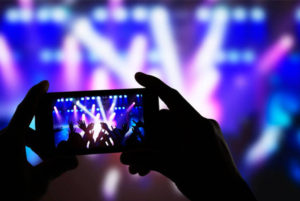How often do you attend events before the COVID-19 pandemic? Whether it’s a birthday party, a product launch, or a wedding reception, these events are always filled with fun. Typically, they can also be crowded. In the zeitgeist that we’re in right now, social distancing is thoroughly encouraged and all forms of massive gatherings have been banned in many countries around the world—including Malaysia. People are also practising the use of e-wallets more than ever. Although we’d love to return to a sense of normalcy, it’s clear that there will be difference in the future.
This begs the million-dollar question: are in-person events still feasible in the age of coronavirus? If (or when) the ban of large crowds are lifted, will society start planning and attending large congregations again? The effects of the pandemic are apparent; having major negative impacts. It’s a global health crisis after all. We know that we can’t exactly pick up where we left off before self-isolation and quarantine—but to what extent? What does the “New Normal” entail?

Photo by Getty Images
The “New Normal” might or might not have a huge influence on product launches or conferences in the future. Let’s have a look at the advantages and disadvantages of virtual versus physical events.
1. Flexibility
Virtual: With digital events being completely online, more people (guests) will be able to join—regardless of where they are in the world. By removing the need to physically be present at an event, guests or invitees can remove certain expected logistics such as travel/transport. The reliance on the Internet and good connectivity will increase by multiple folds. This also calls for a global decrease of the digital divide.
Moreover, organisers can keep their events online for as long as they want. This allows guests (including the media) to return to the events—in case they missed something or just to relive the fun. By keeping the events up for a period after the day of the event, brands can actually capitalise on having a prolonged impression for their products.
Physical: In-person events have been the norm for a long time but a lot goes into planning them—such as the renting of venues and other costs. In addition to that, brands don’t always get everyone they invite to attend; taking into consideration the time and location. For multinational corporations (MNCs), physical events aren’t exactly feasible for the global team to attend.
Physical events last for a few days (if not just a few hours) before ending. Typically, there will be videos and photos of the events; giving attendees the opportunity to take another look. The downside is that you won’t really get to see the event as a whole.

Photo by Getty Images
2. Connections
Virtual: Part of attending an event is getting to reconnect with old friends and make new connections. With virtual events, that aspect will be removed from the equation. You can still talk to people online but it’s definitely different.
When it comes to connecting with a product, attendees can’t do that with virtual events. You can’t touch and feel a product in person; taking away the full experience. However, brands can deliver their products to the guests before the actual event. This allows them to understand the product better. Of course, this can only be done for smaller products such as a new skincare range, the latest vintage champagne, and headphones. Brands can’t really do this with cars.
Physical: In-person affairs allow guests to immerse themselves in the spirit of the brand and product. This includes planning the right music, lighting, decor, and performances. A well-planned setting plays a massive part in the telling of a product’s story. Physical events also help guests understand the product through their own senses. It’s also a lot better for networking—for both brands and guests.

Photo by Getty Images
3. Return On Investment (ROI)
Virtual: We can’t deny the importance of ROI. Whether it’s profit or raising awareness, events are meant to introduce products; launching creations that brands have spent a long time working on. It’s never easy to gauge or measure ROI, especially in the long run. The difference between digital events and in-person events (in terms of ROI) is brand association.
Virtual events can help spread awareness of a specific product online; increasing visibility on a global scale. Brands that capitalise on the prowess of the Internet can introduce their products to the world quicker. However, brands can’t identify how consumers/guests associate with their products. There is no physical relationship between the two entities.
Physical: By providing guests the avenue to be one with a product, brands can actually examine and observe how they respond. Actual interaction with guests can be fundamental to connecting with target audience—and that’s integral to a good ROI. Physical events retain a sense of excitement that virtual events can’t provide (especially with distractions).

Photo by Getty Images
4. Health
Virtual: You can’t talk about the “New Normal” without taking health into consideration. In the age of coronavirus, leaving home can be considered a risk. Wherever you go, you’re bound to come in close proximity to others. This applies to events too. Event tend to be intimate affairs with massive groups of people coming together. Virtual events allow guests to take part and connect in the comfort of their own homes. Hence, minimising the risk of being infected. Brands will have to figure out how to position their products during and after the pandemic—by placing health concerns in their plans.
Physical: In-person events will have to put in place a plethora of safety measures—from enforcing strict social distancing rules to providing masks and hand sanitisers. Practices include taking note of guests’ information and following up post-event. With contact tracing being crucial in this fight against COVID-19, brands that organise physical events will have to ensure that they keep track of every attendee.
In addition to that, organisers will have to consider having a smaller guest list; reducing the risk of infection. In-person events will become more intimate than ever. Unlike the past when many product launches and conferences are packed affairs, physical events in the age of coronavirus have to go by the following rule: “the smaller, the better”. Or in this case, safer.

Photo by Getty Images
There is no doubt that events are fun! Events aren’t just beneficial and crucial to brands and their products but also for guests. It will take time for society to adapt to the “New Normal”—and we will have to be smart about how we do things from now on. An increasing number events have been cancelled or postponed as a result of the COVID-19 pandemic. Furthermore, some brands and organisers are moving their scheduled affairs online; moving into the digital realm.
Whether a physical or virtual event is more feasible, it really depends on the brand—taking objectives and goals into consideration. Whether it’s a launch of the latest car or a tech gadget, there’s no denying that the event landscape will not be the same (oh, Miss Corona). What are your thoughts on this? Are virtual events the way forward or do you prefer physical events?
For more on COVID-19-related stories, click here.
| SHARE THE STORY | |
| Explore More |




